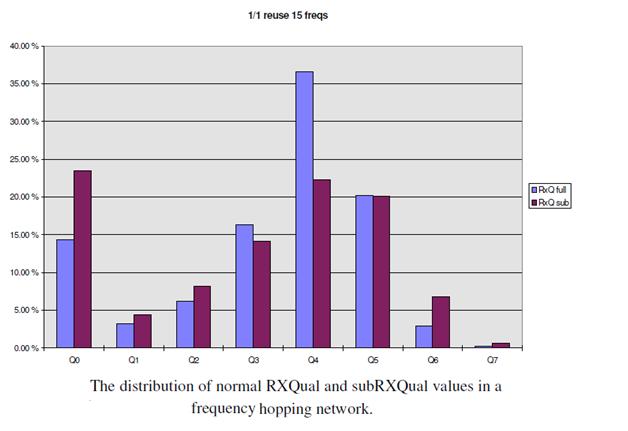DTX has some effect on the RXQual distribution. Normally the BER is averaged over the duration of one SACCH frame lasting 0.48 seconds and consisting of 104 TDMA frames. However, four of these TDMA frames are used for measurements, so that only 100 bursts are actually transmitted and received.
When DTX is in use and there is no speech activity, only the bursts transmitting the silence descriptor frame (SID-frame) and the SACCH are transmitted. When there are periods of no speech activity, the BER is estimated over just the bursts carrying the silence descriptor frame and the SACCH. This includes only 12 bursts over which the BER is averaged (sub quality).
This means that the BER gets averaged much more effectively when DTX is not used yielding to a quality distribution where the proportion of moderate quality values is enhanced. The sub quality distribution is wider than the full quality distribution, meaning that more good and bad quality samples are experienced.
The differences between full and sub quality distributions are largest in frequency hopping networks utilising low frequency allocation reuse, since in that kind of networks the interference situation may be very different from burst to burst.
A couple of severely interfered bursts may cause very bad quality for the sub quality sample when they happen to occur in the set of 12 bursts over which the sub quality is determined. The full quality sample of the same time period has probably only moderate quality deterioration because of the better averaging of BER over 100 bursts. The differences between full and sub quality distributions can be seen in Figure.
 In a real network utilizing DTX the quality distribution is a mixture of full and sub quality samples. The proportions of full and sub samples depend on the speech activity factor also known as the DTX factor. The differences in the BER averaging processes cause significant differences in the RXQUAL distributions. These differences should be taken into account when the RXQUAL distributions of networks utilizing and not utilizing DTX are compared.
In a real network utilizing DTX the quality distribution is a mixture of full and sub quality samples. The proportions of full and sub samples depend on the speech activity factor also known as the DTX factor. The differences in the BER averaging processes cause significant differences in the RXQUAL distributions. These differences should be taken into account when the RXQUAL distributions of networks utilizing and not utilizing DTX are compared.